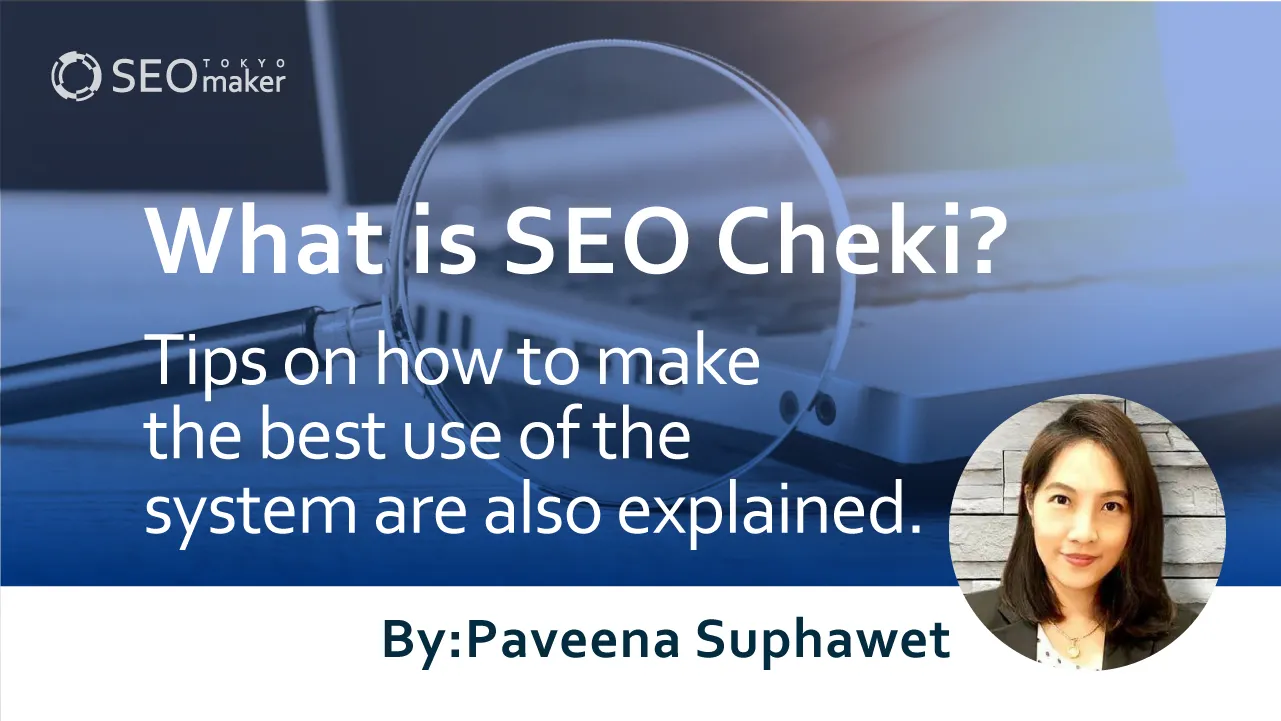What is SEO Cheki? Tips on how to make the best use of the system are also explained.
contents

In the management of web media, deciding on what SEO strategies to implement is of utmost importance. This is because securing a high ranking on search engines like Google and Yahoo! Japan can lead to an increase in the number of visitors over the medium to long term.
To determine the strategies to be implemented, it is indispensable to analyze the current state of one’s own media and research competitor media. SEO Cheki is a convenient tool for performing these tasks.
SEO Cheki can be used completely free of charge, allowing for easy acquisition of information necessary for carrying out SEO strategies. Its user-friendly operability is also one of its attractive features. This article will detail the functions and usage of SEO Cheki, as well as tips for its utilization. Please consider it a reference when advancing your own media’s SEO strategies.
What is SEO Cheki?
SEO Cheki! (Seocheki!) is a free-to-use SEO tool.
SEO stands for Search Engine Optimization, meaning measures to optimize your media pages for higher rankings in search engines like Google and Yahoo! Japan.
Ignoring SEO in web media operation is not an option, as higher search result rankings can lead to an increase in medium and long-term traffic. Deciding on what measures to implement is a critical point.
SEO Cheki is a convenient tool for checking necessary information to proceed with SEO measures. It is completely free to use, and there is no need to download any special applications. It can be easily used on a web browser.
It is recommended for individuals operating blogs or those studying SEO in a corporate setting. Even beginners to web media or SEO can use it without difficulty.
Functions and How to Use SEO Cheki
SEO Cheki primarily has five functions. Although its operation is straightforward and intuitive, some may wish to know what items are available and the meanings behind those items beforehand.
Here, we will explain the five functions of SEO Cheki and how to use them while looking at actual screens. By reading this section, you will be able to start using SEO Cheki immediately.
1.Site SEO Cheki
2.Search Ranking Check
3.Keyword Frequency
4.Outbound Links
5.Who is Information
Site SEO Cheki
One of the main functions of SEO Cheki is the Site SEO Cheki. By entering the URL of the media you wish to investigate, basic SEO-related items for that media are displayed.
The operation is very simple. First, enter the URL of the page you want to check in the URL field on the top screen. Next, click the ‘Check!’ button. Then, the results will be displayed. The page of investigation results will be divided into three sections, and the way to view each section will be explained. First is the part labeled as the top page information.
The title refers to the page title. The description is about the meta description, which is a summary of the page displayed under the title in search results.
Keywords pertain to meta keywords, which are keywords about the page listed inside the HTML tags. The H1 tag indicates the most important heading within the page.
The four pieces of information introduced so far can all be verified by opening the HTML source of the respective page, but extracting specific information from the source can be cumbersome. However, this function of SEO Cheki allows for easy checking.
Moreover, in the section on outbound links, you can learn the number of links set up within the page, including a breakdown of external and internal links. This will be explained in more detail in the section on outbound links later.
Additionally, it is possible to check the last updated date and time, file size, and page load time. Particularly it is important to check the load time. As will be explained later, Google announced in 2018 that page load speed would be reflected in SEO. Be sure to check the loading speed of your own media.
Next, let’s look at the items in the middle of the screen.
The Alexa traffic rank is a ranking compiled by an Amazon subsidiary, aggregating access data of websites worldwide. The higher the rank, the more access the site has, though it’s not particularly relevant to SEO, so it doesn’t require deep consideration.
Additionally, you can find out the index count for Google and Yahoo! Japan. The index count is the total number of pages registered in the search engine’s database.
For example, on Google, you can check the indexed pages by searching with “site:” before the URL. SEO Cheki allows you to easily find out the total count.
Furthermore, you can check the hosting provider, the domain registration date, and the number of likes or shares on social media.
Details on “Search Ranking Check” and “Frequency Check” will be explained later.
Finally, let’s look at the bottom of the page.
Analyze further…” includes items such as “List of Outbound Links” and “Who is Information,” which will be explained later. Clicking on “HTTP Header Information” allows you to view the header information of the respective page.
Also recommended is the “SEO Cheki! Bookmark” Clicking on the phrase “SEO Cheki!” displayed in blue at the bottom allows you to bookmark the page of the investigation results directly.”
From the second time, you can open the screen of the investigation results without the hassle of entering the URL.
Search Ranking Check
The “Search Ranking Check” allows you to investigate the ranking of the page you entered, as the name suggests. You can find out the search ranking at the time of investigation on Google and Yahoo! Japan.
Please select the second tab from the left on the top page. You can also use it from the result screen of the Site SEO Cheki.
Enter the URL of the page you want to investigate in the URL field. Then, enter up to three keywords for which you want to understand the ranking of the respective page. Clicking the “Check!” button will display the results as follows:
In Google, the ranking is basically displayed. However, if the ranking is below 100th place, it will be indicated as “outside the ranking.” In the case of Yahoo! Japan, only rankings within the top 10 can be investigated. If the ranking is lower than 10th place, it will be indicated as “below 11th place.”
Additionally, the rankings of each keyword are displayed in blue text. Clicking these numbers will transition you to the search results of each search engine. It is recommended to jump to the actual search screen to check which sites are displayed at the top.
It is important to note that there is a limit to the number of uses. The search ranking check can be used up to 200 times per day per IP address. However, it is unlikely that you will need to investigate more than 200 times in a day, so there is no need to worry too much.”
Keyword Frequency
The ‘Keyword Frequency’ is also a convenient feature. You can easily find out information such as what keywords are used and how frequently they appear on the page you wish to research.
Please press the middle tab on the top page. Or, it can also be used from the research results screen of the Site SEO Cheki.
Enter the URL of the page you want to check in the URL field and click ‘Check!’ Then, the results will be displayed as follows.
This way, you can see at a glance the total number of words used on the page, the number of times each is used, and their ratio to the total.
As will be explained in more detail later, when analyzing your own media, please check whether the target keywords are properly used and whether collocations are utilized.
Also, when analyzing other companies’ media, investigate which keywords are frequently included and use this information to improve your own media’s articles.
Outbound Links
Using the ‘Outbound Links’ function, you can check all the outbound links set up on the page you wish to investigate. Not only the total number but also the breakdown of the types of links and the destinations can be easily understood, making it a handy feature.
Please press the second tab from the right on the top page. It can also be viewed from the results screen of the Site SEO Cheki.
Enter the URL of the page you wish to investigate and click ‘Check!’
Then, a list of the outbound links for the specified page will be displayed like this.
You can see not only the total number of outbound links but also the breakdown between external and internal links, as well as the number of nofollow links. In the list, external links are in bold, internal links are in regular font, and nofollow links are in green.
Nofollow is a tag used when you do not want the search engines to recognize the link destination. It is used when placing links to pages with low relevance to your own media or when you do not want to associate the link destination with your own media.”
Who is Information
The ‘Who is Information’ allows you to check the Who is information of the domain of the page you wish to investigate. Simply put, Who is information is about the owner of the domain.
Please open the tab on the far right of the top page. It can also be seen from the results screen of the Site SEO Cheki.
When you enter the URL of the page you want to investigate, or the domain URL, the Who is information will be displayed as follows.
You can check information about the domain owner, the date the domain was registered, and until when the domain is valid.
Tips for Improving Search Rankings Using SEO Cheki
With SEO Cheki being free to use and providing essential information related to SEO, it is indispensable. It is useful not only for investigating the status of your own media but also for researching competitor media.
What to focus on when using SEO Cheki to improve search rankings can be divided into two patterns: analyzing your own media and analyzing competitor media. Here are specific tips for each case.
Analyzing Your Own Media
When analyzing your own media with SEO Cheki, it is recommended to pay particular attention to the following points:
- Check page load time with Site SEO Cheki
- Check rankings with Search Ranking Check
- Verify if important keywords are included with Keyword Frequency
Firstly, regarding page load time, research conducted by Google has shown that if a site on smartphones takes longer than three seconds to load, 53% of users will leave. (Reference: Find out how you stack up to new industry benchmarks for mobile page speed (Think with Google))
Google has also announced that page load speed will be reflected in search rankings. If your own media’s loading time is slow, improvements need to be made.
Moreover, using the Search Ranking Check to verify search rankings is crucial. This feature allows you to check the rankings for up to three keywords at once, so make good use of it for effect verification.
With Keyword Frequency, you can check how well you have incorporated important keywords into the page. Please verify the proportion of keywords, collocations, and phrases that appear in suggestions that you have managed to include.
Analyzing Competitor Media
When analyzing competitor media with SEO Cheki, it is recommended to especially check the following points:
- Verify descriptions and H1 tags with Site SEO Cheki
- Check frequently appearing keywords with Keyword Frequency
- Examine the destinations of links set up within the page with Outbound Links
- Firstly, it is necessary to check the basic items with the Site SEO Cheki. Among these, the description and H1 tags are particularly worth paying attention to. A lot of hints can be gathered from the descriptions and H1 tags of competitor media that are ranked high.
- This should serve as a reference when writing or rewriting articles for your own media.
- Additionally, it is necessary to check the keyword frequency. By knowing which keywords are frequently used by competitor media that are ranked high, you can speculate which words would enhance SEO effectiveness.
- It is recommended to compare this with the results of your own media. If there are keywords frequently appearing in top-ranking competitor media but are scarcely used in your own, incorporating them might improve effectiveness.
- Checking outbound links is also crucial. By knowing the number and breakdown of outbound links set up by competitor media, you can use this information for your own media’s outbound link strategy.
- Compare this with the outbound link information of your own media. If your media has fewer outbound links or if there are link destinations not covered by your media, consider this an opportunity for improvement.
Summary
SEO Cheki is a free SEO tool that can be used on a web browser. Its user-friendly operability is appealing, and it allows for easy investigation of the basic information necessary for advancing SEO measures. It is a useful tool not just for those who are just starting to learn about web media and SEO but also for those with some experience. Make good use of SEO Cheki to benefit your own media’s SEO strategies.










![What is a Description? Explaining the Meaning, Writing Style, and Changing Word Count – [2023 Edition]](https://www.switchitmaker2.com/en/wp-content/uploads/2024/09/what-is-description.webp)










